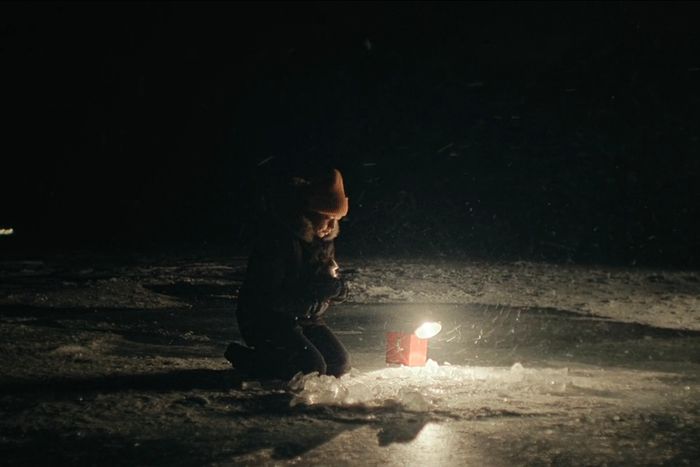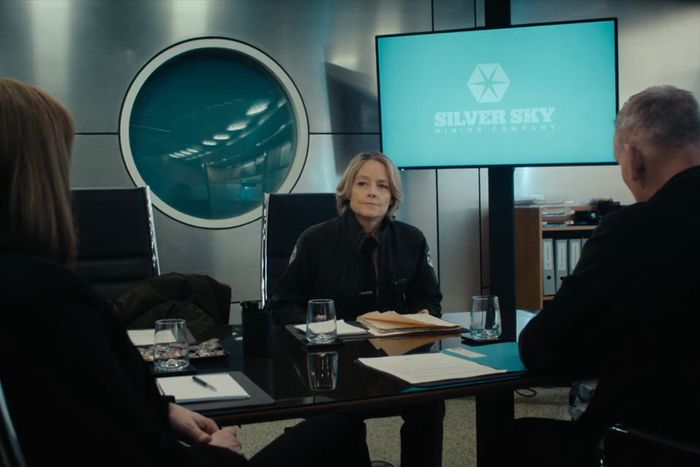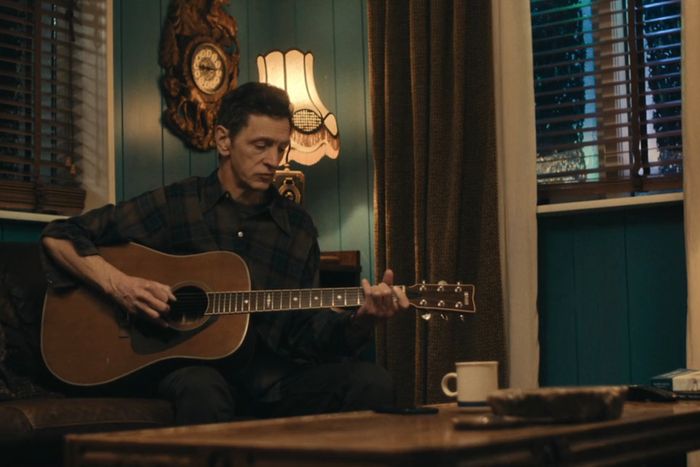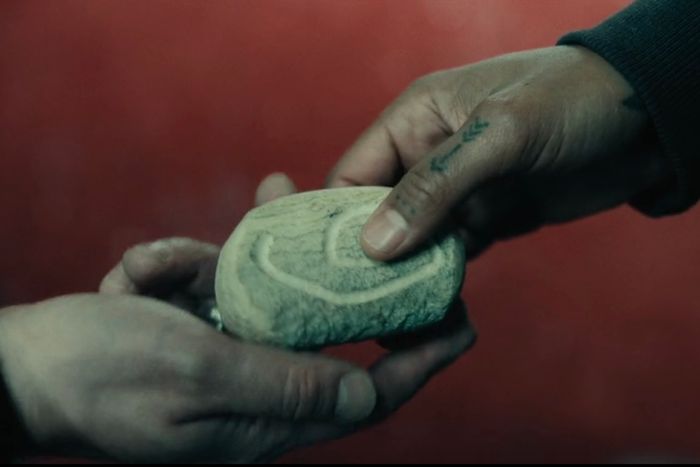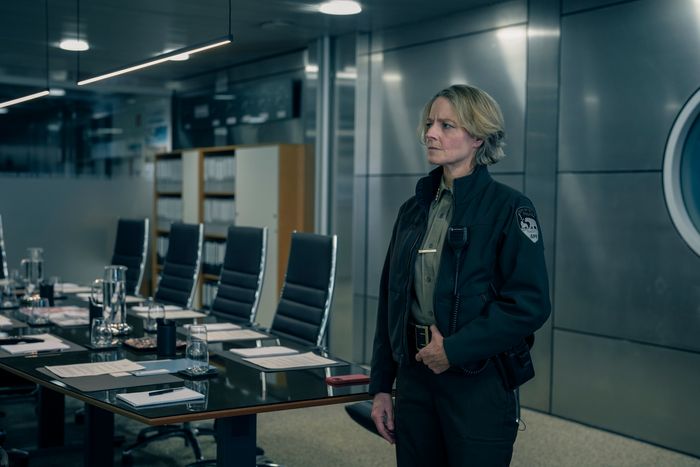
Spoilers ahead for“Part Five” of True Detective: Night Country, now streaming early on Max. It will air on HBO Sunday night in its normal time slot.
The penultimate episode of True Detective: Night Country understands that we’re running out of time to finish this story — and, possibly, for Danvers and Navarro, to solve the mysteries behind the deaths of the Tsalal scientists and Annie K. So it doesn’t mess around, mince words, or hold back any bullets. Specifically, bullets that kill two crucial people: Otis Heiss, the drug-addicted victim of a mysterious attack who, thankfully, shows Danvers how to get to the ice caves before he dies; and Hank Prior, who is shot in the head by his own son, Pete, before Hank can shoot Danvers.
Even though Navarro insists that she and Danvers have to get to the ice caves right away — “We are this close … but that’s why we have to go now!” — the show does take a beat to sit with the mess that’s just been made in Liz’s front hallway. Poor Pete is now stuck with two dead bodies to get rid of, a ton of spilled blood to mop up, and also the traumatizing reality that he just murdered his own father, albeit justifiably. Navarro offers assistance with one aspect of that to-do list, advising Pete to bring the bodies to Rose Aguineau, then tell her to “take me to Julia,” a reference to the isolated area where the ice was thin enough to break through so Navarro can place her sister’s ashes in the water.
The supernatural continues to ooze through Night Country, but practicality is also a running theme in “Part Five.” We can see it in Danvers’s attempt at pragmatism when she initially tells Navarro the Tsalal case is dead and that they both need to let it go; in much more sinister matter-of-factness from Kate McKitterick, who owns and operates Silver Sky Mining and instructs Hank to make sure Danvers “can’t find that cave”; and even in the episode’s focus on the various ways that the people of Ennis deal with laying their bodies to rest, as if any body ever really rests around here. Let’s start there.
.
Bury a friend … if you can dig a grave
This episode considers what happens after death through three different approaches to handling a corpse. It opens with a detailed sequence of an woman going through the process of cleaning out a furnace, cremating Julia’s remains, and packaging the ashes to hand to Navarro. The way the woman goes about her work is businesslike — you can tell she does this many times a week — but also reverent. It’s especially heartbreaking when she warns Navarro that the urn is hot and Navarro hugs it tight to her chest anyway, as if she is giving her sister one last, warm embrace.
Later in the episode, Danvers goes to a holding facility for dead bodies that can’t be buried until the ground starts to thaw in the spring. Many of the caskets are tiny because they contain the infants who have been dying because of the poisonous water supply. Seeing those small coffins convinces Liz she can’t drop the Annie K. or Tsalal cases, even if Connelly does make good on his threat to reveal that Navarro actually killed William Wheeler and covered it up with Liz’s help. Those dead babies remind her too much of her own.
Holding facilities like the one Liz visits are based on reality. As this L.A. Times article explains, it’s common practice in Alaska to schedule interments for the spring months since it is so difficult to dig graves during the winter. The article also notes that many “Alaska Natives choose not to wait to bury their dead” and use fire and pickaxes to break through the ground so they can dig a proper hole, which is somewhat similar to what Rose and Navarro do when they lay Julia to rest.
On True Detective, there’s also a third burial option: Head to Rose Aguineau’s and drop your loved ones into the sea in a place where no one will ever find them, as Navarro tells Peter to do after he kills Hank. One wonders how many times Rose, or anyone else, has done this here in Ennis, which seems like an ideal place for people to cover up murders, especially at this time of year. It’s dark, isolated, and, assuming you don’t mind putting in some serious effort in subzero temperatures, a location that makes it relatively easy to make sure a corpse disappears for good.
It’s interesting that these three methods — cremation, holding a body in storage, and dumping a body into the ice — constitute a sort of trinity, if you will. True Detective has always been attracted to things that happen in threes: the narratives in seasons one and three took place across three different timelines; season two focused on cops from three different departments; and in season four, Navarro believes she is the third person in her family, in addition to her mother and sister, who is cursed by visions that will eventually lead to her death.
So does this trinity of rituals add up to a real theory, or is it just eerie? I’m not sure it adds up to a theory so much as provides an opportunity to show three — again with the threes! — principal characters (Danvers, Navarro, and Peter) confronting mortality and the sobering realities that come with trying to put dead bodies in the ground.
.
We get it, she’s awake. But, dammit, who is she??
We’ve been asking this question since the first episode, when we saw Clark say “She’s awake” just before his seizure, and Danvers and Navarro hear the same message. When Danvers questions Otis at the rehab facility, he tells her that the last time he saw Clark, he said “She’s awake” a “bunch of times.” He mentions that Clark also said, “She’s out there.”
The most logical explanation is that “she” refers to Annie K., whose spirit may have haunted the Tsalal scientists, has definitely been haunting Navarro, and is finally haunting Liz thanks to the words Navarro says to her. “You carry her now, like I did all this time,” she says, handing Annie’s file to Danvers as if she’s just placed a curse on her former partner. Navarro also sees a vision of Annie during the mine protests, suggesting her ghost is definitely still hanging around.
I get bigger and deeper vibes from the way people are using “she,” though, almost as if the word refers to the spirit or spirits that make Ennis essentially a gateway to the other side. Once again, we see Navarro flash to all the people who have pointed at her in her visions: Holden, the scary-ass wet woman who confronted Julia, Anders Lund, and a fourth woman who could be Navarro’s mom. Do these images collectively represent some metaphysical “she”? Otis also recalls that he and the other men who fell through the ice on the night of his accident heard screaming. Could that have come from “she”?
Does the “she” question add up to a real theory, or is it just eerie? It’s definitely eerie, and knowing who “she” refers to will explain a lot. The finale really needs to answer this question more definitively.
.
The mine theory: confirmed!
Remember in episode three when Navarro was like, “Hey, Danvers, the mine is totally connected to Tsalal and Annie K., and Hank is probably involved in the cover-up” and Danvers was like, “Hahaha, oh my God, you’re a crackpot?” Well, who’s the crackpot now??
Navarro was absolutely right, and we know this for two reasons. The first: because Pete continued to follow the money like a good little Woodward and Bernstein, uncovering tax records showing that Tuttle United, the company that is helping to fund Tsalal, does deals with Norbank Securities, a founding partner of Silver Sky Mines. In case those details fly over the audience’s head, Danvers offers this very helpful and explanatory piece of dialogue: “The mine bankrolls Tsalal and then Tsalal pushes out bogus pollution numbers. This is evidence.”
The other reason we know the mine is involved is because McKitterick tells us so during her meeting with Hank. While asking him to basically kill Otis and Liz to keep the truth a secret — “I never said those words,” she protests when Hank implies she’s asking him to commit murder, a thing she absolutely is doing — she lays out the terms of their whole arrangement. She paid off Hank and promised him the job of police chief in exchange for his assistance in squashing the investigation into Annie’s death.
He didn’t get the chief job because Connelly unexpectedly stuck Danvers with it, and he blew all the cash on a mail-order-bride scam. So he still needs money and this time, if he can make Annie K. and Tsalal go away, McKittrick promises he will become chief. That’s why he shows up at Liz’s place, attempting to track down Otis, who happens to be shooting up some quality police-evidence heroin in Liz’s bathroom.
Would Hank really be willing to risk so much just for some cash and a job as chief of police in a very small Alaska town? Night Country has crafted his character to suggest that he would. His Achilles’ heel is his need to prove his own masculinity and authority, whether this means marrying and “rescuing” a beautiful Russian woman, going hunting for fugitives with his hillbilly buddies, or smacking his son around.
I can buy that he would be that much of an asshole. I find it harder to believe that, until Peter started digging around, no one had discovered the connections between Tsalal and the mine. The mine is obviously a controversial presence in Ennis. One would think that an activist or a journalist — assuming any journalists live near Ennis in this era of dying journalism — would have looked into this. Prior is diligent, but it’s not like he needed to do magic tricks to find this documentation. It’s all there to be found for anyone who wants to look. All the business with the funding of Tsalal feels deliberately drawn out so that its revelations come at exactly the right point in the narrative, which: Okay, I guess.
Is the mine theory a theory or just eerie? Oh, it’s all of it. It’s eerie, a theory, and now, it’s fact.
.
Sing us a song before you die, Hank Prior
Peter told Leah in a previous episode that his dad wanted to be a musician but it didn’t pan out. When she asked if he’d ever heard Hank sing, Peter said no, cringing at the prospect. Well, Peter finally does hear his dad sing in this episode when he gets kicked out of his house, heads to Hank’s, and overhears him strumming out a number on his guitar.
An HBO rep confirmed that John Hawkes, who plays Hank, wrote and performed the song, called “No Use,” specifically for the show. In addition to proving that Hank actually has legitimate musical talent — and might have been a nicer guy if he had gotten to pursue it — the song sonically connects Hank’s private moment at home to the angry protests taking place at the mine.
“There is no place/ To get unwound/ You will not sing/ You lost your sound,” go some of the lyrics. “There is no God/ No hallowed ground,” say others. It’s clear Hank wrote this about himself and the lost promise of his own life. But the lyrics apply even more keenly to the plight of the people outside the mine screaming, “We were here before, gonna stay when you’re gone!” while troopers move in to silence them. No hallowed ground, indeed. The black paint across the mouths of Leah and her fellow resisters illustrates the real tragedy in Ennis — that their voices aren’t being heard — and Hank’s need to compensate for his inadequacy by hiding what happened to Annie is only making matters worse.
The last thing Hank says to Peter before he dies is “Blood is blood.” He believes he is reminding his son that their familial bond supersedes everything and that Pete won’t kill him because of that. But “Blood is blood” can also be interpreted another way: All blood is the same, and Annie deserves justice just like anyone else. That comment underlines the rift between Ennis’s white and Native residents, a huge theme in the series but one particularly notable in this episode. A lot of white people are not allies of the people who were here before (wasn’t it sweet how Sheri completely ditched Leah in her time of need?), but maybe Peter and even Liz still can be.
Does the song add up to a theory? No, it’s just a cool and illuminating detail in a series that does an excellent job with its needle drops.
.
Mom, the spiral symbol is back again.
This thing does not want to go away, does it? Qavikk tracks down Navarro to return the rock with the symbol that she left at his place and brings some random dude with him who remembers seeing the iconography around Ennis when he was a kid. He says the spiral symbols were often left as a warning for hunters in “places where the ice would swallow them whole.” Perhaps in a place near those ice caves, for example.
We’ve talked before about how this iconography relates back to True Detective season one and also how some version of a spiral exists in many, many cultures throughout history. The Symbolikon website notes that in Taino art, spirals can symbolize “cosmic energy” or “sweet water.” Perhaps in Ennis, the symbol originally was connected to water as well.
Given the connections to Ireland in this season — remember when we talked about the significance of the name Ennis three “Clue Detective” columns ago? — I’m also intrigued by the Celtic symbol called the triskelion, which is composed of three linked spirals. (What’s that, a trinity, you say?) The meaning of a triskelion may be different depending on the way in which it’s drawn: As this website notes, when the spirals in it are drawn clockwise, they suggest a connection to harmony or earth. If they’re drawn counterclockwise, they are “thought to be pagan symbols that manipulate nature.” In other words, the meaning of this symbol may change depending on the context.
Does the symbol add up to a theory or is it just eerie? Oh, it’s been eerie, but I still don’t know if it necessarily tells us anything about the deaths of Annie and the scientists.
.
Finally, please allow Frozen to enter this narrative.
After Danvers tells Navarro about the bogus forensics report from Anchorage and tries to convince her the case is being shut down, she repeats one phrase over and over: “Let it go.” If you were the parent of a young child in 2013, the year Frozen came out, or honestly any year since then, you are incapable of hearing those words without immediately thinking of that hugely successful Disney film.
Which made me consider the similarities between Frozen and Night Country. Seriously, think about it: Frozen tells the story of two sisters joined and driven apart by a traumatic experience. It’s about losing loved ones and a woman with magical powers that manifest themselves in snowy, icy climates. It’s about a town that gets stuck in an infinite winter. In Frozen, Olaf the snowman sings a delightful musical number called “In Summer,” which is exactly what Anders Lund does when he suddenly comes back to life after being frozen to death in Night Country! Okay, Lund doesn’t do that, but, wow, imagine how much scarier that scene would have been if he did!
Is this actually a theory or just eerie? I contend that it is a little eerie, and also the stupidest thing I have written in this column so far.



